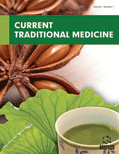Abstract
Type 2 diabetes mellitus (T2DM) is a developing worldwide issue. Traditionally, different plants have been used throughout history to lower blood glucose and improve the impact of diabetes. Also, today, many natural products have been introduced to lower blood glucose in T2DM patients. The beneficial effects of genistein, the most essential and abundant isoflavone of soybean (Glycine max (L.) Merr.), on blood glucose and other metabolic indicators, as well as diabetesrelated complications, have been widely investigated. In the current narrative review, through a thorough search from "2013-2020” in “PubMed", "Scopus", “ResearchGate”, “Google Scholar”, and "Web of Science" databases, we have retrieved, reviewed, and summarized all clinical trials, as well as in vitro and in vivo studies on the anti-diabetic potential of genistein.
Keywords: Anti-diabetic, genistein, soybean, isoflavones, Glycine max, T2DM.
[http://dx.doi.org/10.1007/s00508-019-1450-4] [PMID: 30980151]
[http://dx.doi.org/10.3390/ijms21176275] [PMID: 32872570]
[http://dx.doi.org/10.1097/00005082-200201000-00003] [PMID: 11800065]
[http://dx.doi.org/10.3945/ajcn.115.114389] [PMID: 26843157]
[http://dx.doi.org/10.1001/jama.298.22.2654] [PMID: 18073361]
[http://dx.doi.org/10.1136/bmjdrc-2020-001375] [PMID: 32675292]
[http://dx.doi.org/10.26719/emhj.19.035] [PMID: 32003448]
[http://dx.doi.org/10.1152/physiol.00003.2018] [PMID: 29412061]
[http://dx.doi.org/10.2337/dc10-1414] [PMID: 21357362]
[http://dx.doi.org/10.3390/diagnostics10050314] [PMID: 32429441]
[http://dx.doi.org/10.2337/diab.32.2.S64] [PMID: 6400670]
[http://dx.doi.org/10.3390/genes11091091] [PMID: 32962051]
[http://dx.doi.org/10.1056/NEJMra021678] [PMID: 14702427]
[http://dx.doi.org/10.1016/j.ophtha.2010.06.022] [PMID: 20884058]
[http://dx.doi.org/10.1038/s41433-019-0566-0] [PMID: 31488886]
[http://dx.doi.org/10.1167/iovs.16-19964] [PMID: 27701631]
[http://dx.doi.org/10.2337/dc06-0650] [PMID: 17130202]
[http://dx.doi.org/10.1152/physrev.00045.2011] [PMID: 23303908]
[http://dx.doi.org/10.3389/fendo.2017.00006] [PMID: 28167928]
[PMID: 32351908]
[http://dx.doi.org/10.1016/j.jtcme.2017.08.012] [PMID: 29992107]
[http://dx.doi.org/10.1039/C2FO30199G] [PMID: 23160185]
[http://dx.doi.org/10.1016/j.maturitas.2016.12.004] [PMID: 28159061]
[PMID: 22419027]
[PMID: 29528085]
[http://dx.doi.org/10.1080/19396368.2021.2003910] [PMID: 34986716]
[PMID: 30997768]
[http://dx.doi.org/10.1016/j.biopha.2019.108670] [PMID: 30784939]
[http://dx.doi.org/10.1038/s41598-018-23530-z] [PMID: 29581465]
[http://dx.doi.org/10.1007/s12020-014-0265-3] [PMID: 24752394]
[http://dx.doi.org/10.1006/taap.2000.9019] [PMID: 11042097]
[http://dx.doi.org/10.3389/fendo.2012.00094] [PMID: 23060856]
[http://dx.doi.org/10.3390/nu14183768] [PMID: 36145144]
[http://dx.doi.org/10.3390/molecules200917016] [PMID: 26393547]
[http://dx.doi.org/10.1002/jcb.26356] [PMID: 28816409]
[http://dx.doi.org/10.1016/j.ijbiomac.2017.07.132] [PMID: 28756197]
[http://dx.doi.org/10.5603/FHC.a2018.0014] [PMID: 29998457]
[http://dx.doi.org/10.1007/s40200-020-00648-4] [PMID: 33553029]
[http://dx.doi.org/10.1021/jm501069h] [PMID: 25347820]
[http://dx.doi.org/10.1016/j.jnutbio.2018.04.018] [PMID: 29885598]
[http://dx.doi.org/10.1016/j.jtemb.2020.126606] [PMID: 32650064]
[http://dx.doi.org/10.2147/DMSO.S216312] [PMID: 31686880]
[http://dx.doi.org/10.1093/toxsci/kfy162] [PMID: 29982808]
[http://dx.doi.org/10.1016/j.jmau.2015.03.005] [PMID: 30023190]
[http://dx.doi.org/10.1016/j.taap.2014.08.028] [PMID: 25178718]
[http://dx.doi.org/10.1177/0192623314526318] [PMID: 24713318]
[http://dx.doi.org/10.1016/j.jsbmb.2015.06.002] [PMID: 26134426]
[http://dx.doi.org/10.1038/srep22854] [PMID: 26973284]
[http://dx.doi.org/10.1016/j.jcjd.2019.04.007] [PMID: 31307913]
[http://dx.doi.org/10.3164/jcbn.15-147] [PMID: 27698541]
[http://dx.doi.org/10.1017/S0007114515003359] [PMID: 26370252]
[http://dx.doi.org/10.1038/ejcn.2016.117] [PMID: 27380886]
[http://dx.doi.org/10.1007/s00125-014-3463-x] [PMID: 25533387]
[http://dx.doi.org/10.1038/ejcn.2017.76] [PMID: 28488690]
[http://dx.doi.org/10.1210/jc.2013-1180] [PMID: 23824420]
[http://dx.doi.org/10.1017/S0007114516000581] [PMID: 26949260]
[PMID: 32418714]
[http://dx.doi.org/10.1002/mnfr.201400390] [PMID: 25351561]
[http://dx.doi.org/10.3109/01913123.2015.1045664]
[http://dx.doi.org/10.1007/s11010-015-2483-2]
[http://dx.doi.org/10.1155/2013/510212]
[http://dx.doi.org/10.4314/tjpr.v14i11.10]
[http://dx.doi.org/10.2147/DDDT.S249608] [PMID: 32884237]
[PMID: 28804612]
[PMID: 29085595]
[http://dx.doi.org/10.1038/s41580-018-0089-8] [PMID: 30655609]
[PMID: 29238465]
[http://dx.doi.org/10.1016/j.bbrc.2016.07.039] [PMID: 27431618]
[http://dx.doi.org/10.1097/01.EHX.0000473710.76297.3b]
[PMID: 27042131]
[http://dx.doi.org/10.1186/s12902-016-0144-4] [PMID: 28183304]
[http://dx.doi.org/10.1016/j.jnutbio.2012.02.011] [PMID: 22819564]
[http://dx.doi.org/10.1515/jbcpp-2017-0155] [PMID: 29561730]
[http://dx.doi.org/10.1159/000471932] [PMID: 28376494]
[http://dx.doi.org/10.1016/j.cbi.2017.02.021] [PMID: 28259689]






























